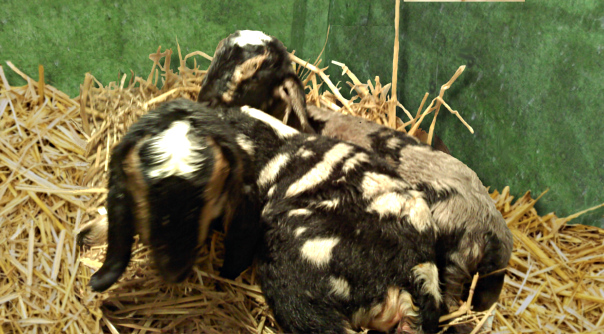

LINKS
|
|
|
|
|
|
Goat Herd Health Program
Steven E. Hubbard, DVM
sehdvm1@yahoo.comPlease Click Here For Goat Herd Health Program in PDF Format
Please Click Here For Medications Commonly Used in Goats and Approximate Withdrawal Times in PDF Landscape Format
At Birth
1. Spray/dip navel with tame iodine or chlorhexidine-do not use 7% Iodine. Clip navel if too long
2. Feed Colostrum – a must within the first 12 hours-first 1-2 hrs. is best.
Give 1 ounce/pound body weight 3- 4 times in the first 24 hrs. following birth
a. Colostrum from CAE/Johne’s negative doe
b. Heat treated colostrum: 135 degrees F for one hour
c. Cow colostrum (heat treated)
3. Keep kids warm and dry-do not overheat if using lamps
a. Most common causes of deaths are hypoglycemia and hypothermia
b. If kid will not nurse – give ½ cc of Vit B complex orally, wait 15 minutes then try to feed again
4. Examine kids for abnormalities i.e. supernumerary teats
5. Give Vit E/Se (1/2 cc Bo-Se) and Vit A (1/4-1/2 cc)
6. Weigh Kids
7. Continue feeding goats milk or kid replace
a. Lamb replacer is too high in fat
b. Calf replacer is too low in protein
c. Non goat replacers may contain too much lactose causing bloat
Age 1-4 weeks
1. Should be eating hay/grass by 2 weeks; grain by 4 weeks
2. Dehorn, remove wattles, tattoo, castrate
Age 4-8 weeks
1. Give tetanus toxoid and enterotoxemia C & D
a. 4 weeks and booster in 4 weeks
2. Initiate coccidia prevention
a. Coccidiastat medicated feeds
b. Rumensin is toxic to horses
3. Monitor for internal and external parasites
4. Diet should consist of milk, grain and forage
a. Maximum of 2 qts. of milk/day
b. Stimulates increase grain/hay intake
Age 8-12 weeks
1. Vaccinate if not done previously
2. Monitor for parasites
3. Wean from milk when kids are 2-2 ½ times their birth weight
Yearling
Purpose is growth, not fattening
1. Should be able to feel the rib
2. ½ - 1 ½ lbs. Grain daily plus forage
3. Breed according to weight not age
a. When approximately 70% of adult weight
DOES
Dry Does
1. Do no allow them to become FAT
2. Maintain exercise
3. If pasture/hay is not sufficient supplement with 1/4 to 1/2 lb. of grain daily
4. Pure legume hay should not be fed prior to kidding
5. Allow 2 months dry period before kidding
6. Give annual vaccination: tetanus, enterotoxemia, C&D 2-4 weeks prior to parturition. Use caution if giving BO/SE to late term does.
Milking Does
1. Feed approximately ½ lb. Grain per 1 lb. Milk produced
2. Amount/quality of grain depends upon quality of pasture and hay
3. Feed according to individual doe’s ability to convert feed into milk and not body fat
BUCKS
1. The buck produces HALF of the herd genetics
2. Select superior bucks free of defects and disease
3. Worm, vaccinate, trim feet with the same regularity as the does
4. Supply fresh water, adequate nutrition and exercise
During non-breeding season supplement with ½-1 lb. Grain/daily
5. Two week prior and during breeding season
Increase grain to 2-3 ½ lbs. daily
Base amount of grain on usage, activity and body condition
6. Do not overuse the buck
The number of does a buck can breed increases with age
7. Clip prepucial hair prior to breeding season
PARASITOLOGY
1. Do fecals, use FAMACHA, selective deworming, use proper dosages
2. Practice prevention : www.scsrpc.org
3. Eliminate the genetic susceptible goats (20/80 rule)
4. New animals: isolate from herd, do fecals, worm if needed and recheck fecals before introducing them to your herd
5. Check for external parasites (lice and mange) especially during the winter months. Check any goat that is in contact with yours i.e. if you provide buck service
PREVENTATIVE MEDICINE
1. Maintain adequate diet
Supply fresh water, trace minerals and salt
2. Maintain clean, dry, well ventilated housing
Decreases pneumonia, parasite and feet problems
3. Trim feet as needed – monthly in some cases
4. Keep Records
Birth dates, breeding dates, tattoo
Vaccinations
5. Test for TB, Brucellosis, Johne’s and CAE as your program demands








JHFarms
Diana, Steve and Kirk Hubbard
25307 Dole Rd.
W. Harrison, IN 47060
All Rights Reserved 2014